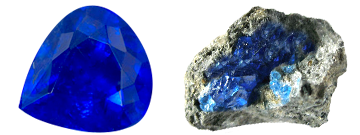 Photo of Hauyne in Processed & Rough Form
Photo of Hauyne in Processed & Rough Form
Hauyne is a mineral with a hardness of 6 out of 10 on the Mohs scale of mineral hardness [?]. These Cubicly structured gems are made of sodium aluminum silicate, their full chemical compound being (Na,Ca)4-8Al6Si6(O,S)24(SO4Cl)1-2.
Hauyne is a blue feldspathoid rock-forming mineral, one of four members of the sodalite mineral group that is a component of lapis lazuli. The other three are lazurite, sodalite, and nosean. It is a complex mineral of sodium, calcium, aluminum silicate, and sulfate.
Hauyne forms very bright and attractive though uncommon transparent blue dodecahedral or pseudo-octahedral crystals of the cubic system. It is found more often in rounded, blue, white, and occasionally green grains. It is hard, brittle, has perfect dodecahedral cleavage, and conchoidal to uneven fracture. It is soluble in acids, leaving a silica gel, and fuses easily to a blue-green glass.
It is transparent to translucent, and has a vitreous to greasy luster. Some of this material has been reported to show an orange-red fluorescence under LWUV (long wave ultraviolet light).
Hauyne occurs in alkaline nepheline or leucite-rich igneous rocks, phonolites, and related undersaturated igneous rocks. It forms in silica-poor lavas.
Samples are found in the lavas of Vesuvius and the volcanoes of Lazio, associated with leucite and melilite in tuffs in the Alban hills and in hauynophyres at Monte Vulture (Basilicata) - all in Italy. It has also been found in volcanic bombs in the Rhineland, in lavas in Morocco, and in andesites in France.
It is also known as hauyinte, hauyne, roeblingite.
The specific gravity [?] for Hauyne is 2.4, its refractive index [?] is 1.50 (mea, and its double refraction [?] is None.
History
Hauyne was first described in 1807 from samples found in Vesuvian lavas in Monte Somma, (Italy), and was named in 1807 by Brunn-Neergard for the French crystallographer Rene Just Hauy.
Industrial Usages
Hauynite is a suitable mineral for collectors and of interest to scientists. Fine bright blue crystals come from Mendig and Mayen in the Eifel region of western Germany.









